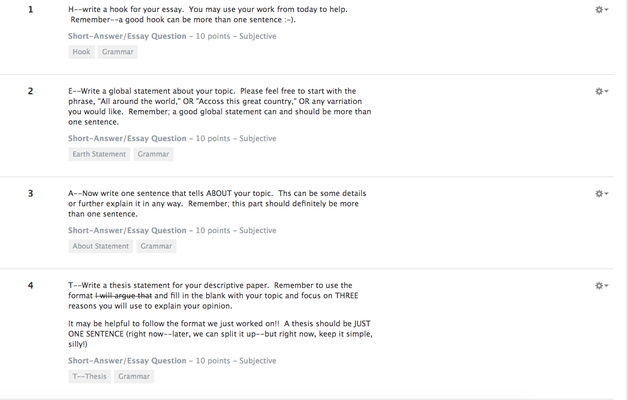"I have a birth defect--no herd instinct."My mother used to tell me that the quote above was from one of the first women arrested for wearing an "unauthorized" bathing suit to a public pool back when women did not do such things as show their ankles or wrists. Unfortunately, (as we have spent the last three weeks on expository essays), I cannot verify that source. Regardless, the quote has always resonated with me. With that in mind, I'd like to share something my last handler (shout out to Jeffrey Bernadt--@jefferybernadt) said was unique about how I set up Schoology to grade introduction and conclusion essays. Using the test feature in our learning management platform (LMP), I set up four questions to count as the rough draft of the introduction paragraph of our essay essay (which is expository this time). We use a system I call H.E.A.T. (Hook, Earth, About, Thesis) as a pneumonic to remember the sentences we need to have somewhere in the opening paragraph. Most of you writing people will know that the hook is there to reel in the audience (attention getter) and the thesis is our argument plus essay map. Earth means they need to have a global appeal in there, making their reader feel a part of the issue. I use the example, "All around the world, people need ______" as a template to show that their topic is universally critical. The about statement is the literal definition of the topic. As you can see from the grayed out boxes under the questions, each sentence (or set of sentences) that they write then goes up against a rubric. The rubric judges two things--does the statement they wrote do what they were asked (is it a hook? is it a thesis?). The second box is grammar. If there are any grammar mistakes in the answer, they do not get points for the grammar component of the sentences.
Considering that I always invite students to redo their work for a better grade, I find this system pinpoints the potential problems or successes of their sentences. This leads to less confusion about why they received the grade they did and better understanding on how to fix it. They know immediately from looking at the rubric if they need to work on content or grammar (or both) in their next submission. I will not suggest that this method of grading saves time; however, it does save a good bit of my sanity by having the bulk of the "why didn't I get a 100 on this?" questions taken care of without personal interaction with the student or handwritten notes/emails.
0 Comments
Leave a Reply. |
Archives
April 2024
Categories |
 RSS Feed
RSS Feed


